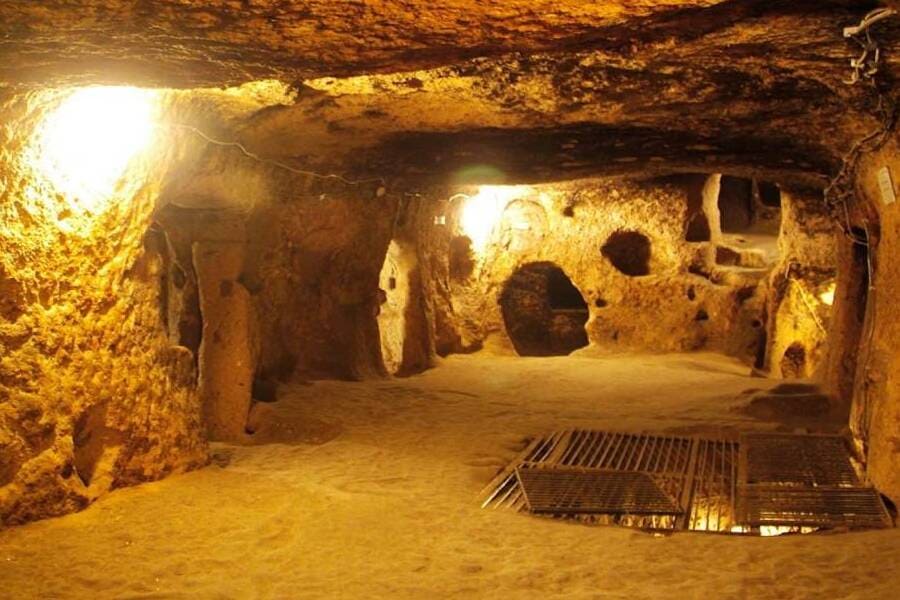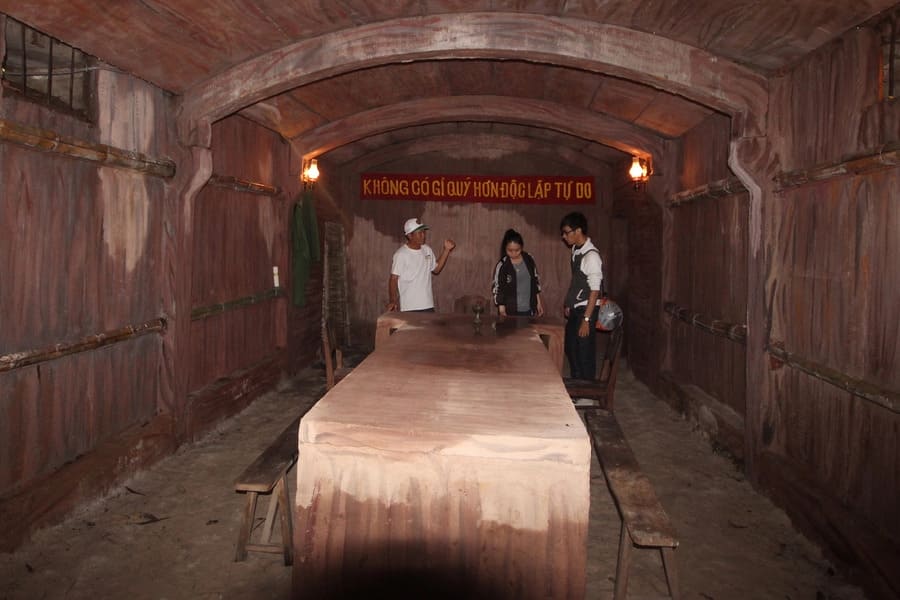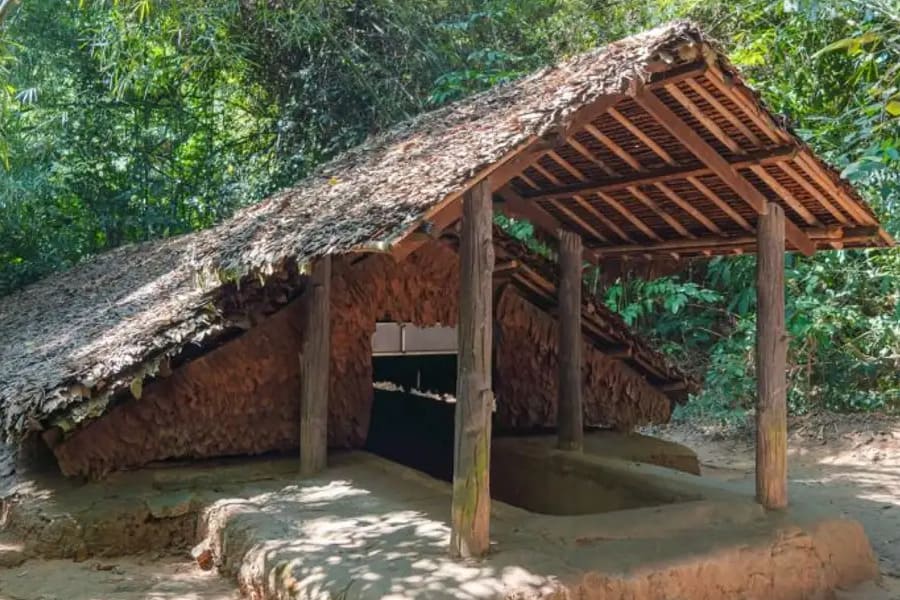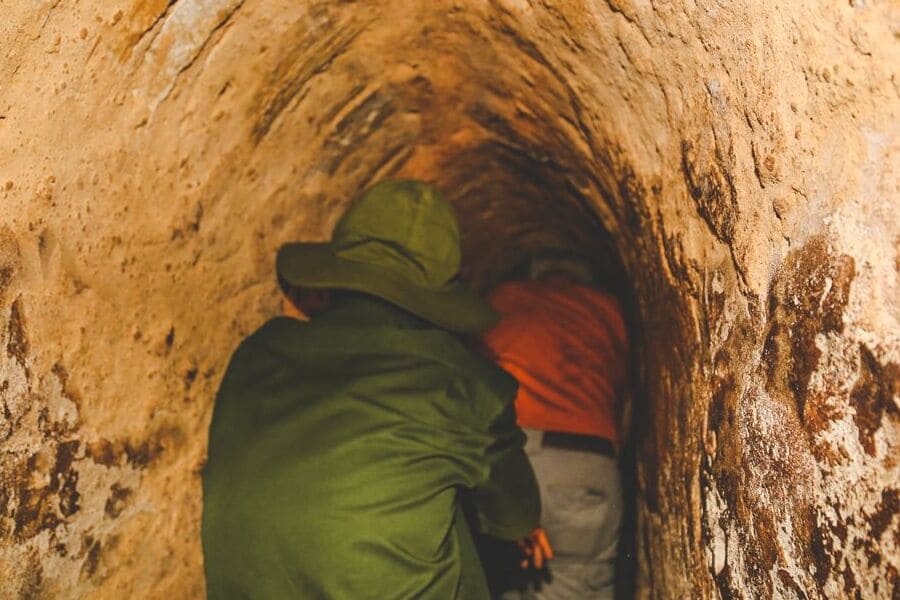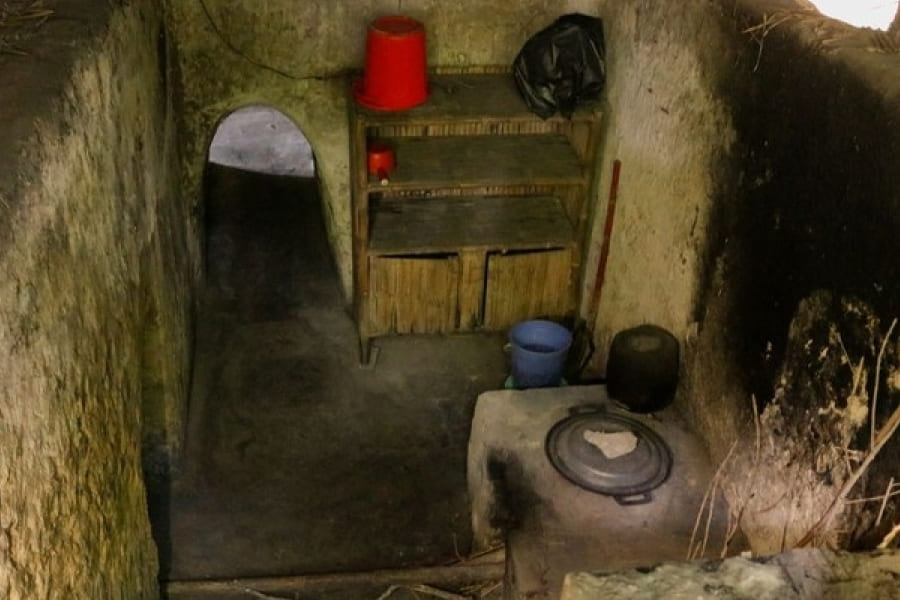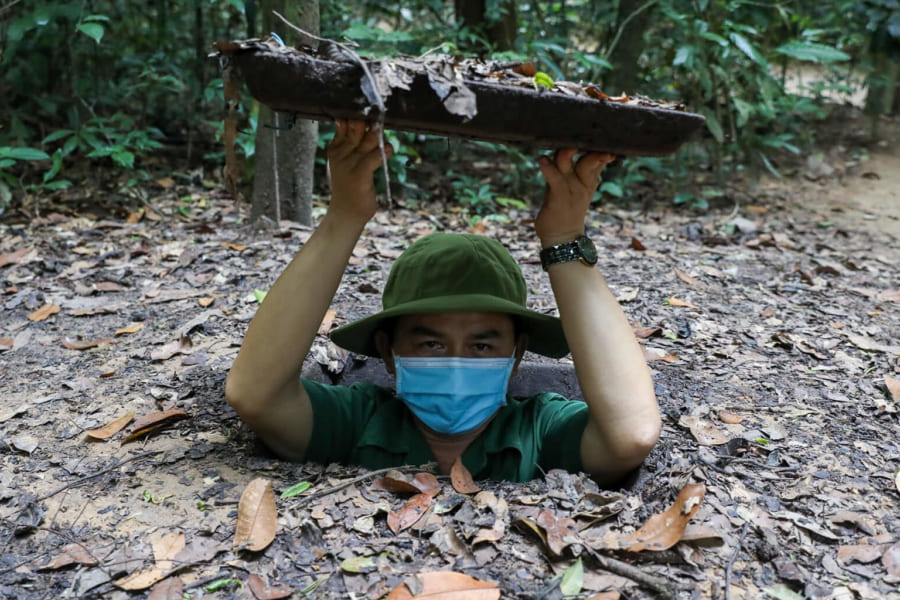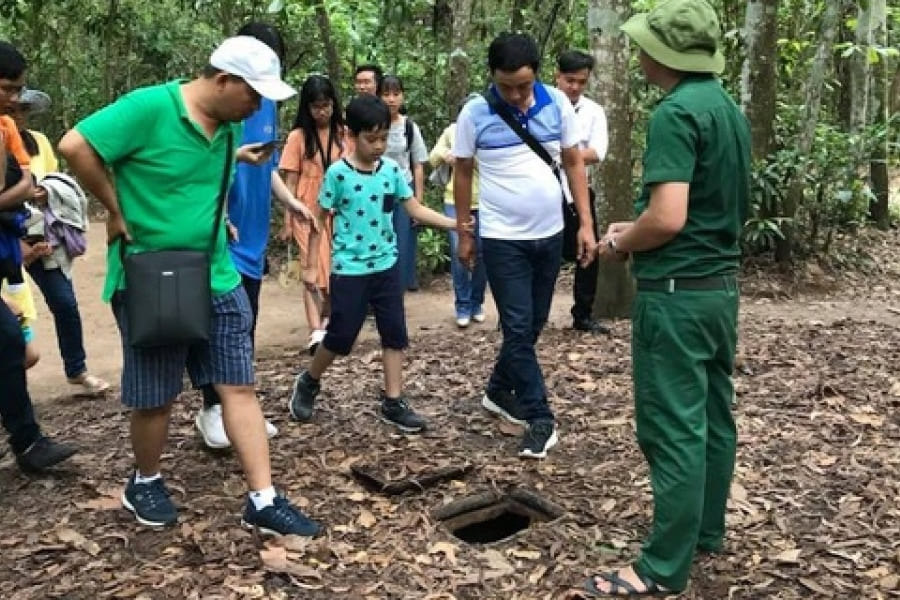Beneath the bustling surface of Ho Chi Minh City lies a remarkable relic of history – the Cu Chi Tunnels of Saigon. Revered as one of Southeast Asia’s top adventurous destinations and among the globe’s most intriguing underground wonders, this labyrinthine complex transports visitors back in time to the tumultuous era of Vietnamese history. The Cu Chi Tunnels, spanning decades old and intricately designed, epitomize a sophisticated maze concealed beneath the earth’s surface. Here, visitors can immerse themselves in the gripping narrative of wartime Vietnam, gaining firsthand insights into the resilience and ingenuity of Vietnamese soldiers.
Where is the Cu Chi Tunnels?
The Cu Chi Tunnels are situated in Cu Chi District, approximately 70 kilometers northwest of the bustling center of Ho Chi Minh City, Vietnam. This location places them in a suburban area known for its historical significance and lush landscapes. The tunnels are renowned for their role during the Vietnam War, offering visitors a glimpse into the country’s military history and the ingenuity of its soldiers.
There are two main sites where visitors can explore the Cu Chi Tunnels – Ben Dinh and Ben Duoc. Ben Dinh Tunnels, located in Nhuan Duc Commune, and Ben Duoc Tunnels, situated in Phu My Hung Commune, both preserve sections of the extensive underground network. These sites are popular attractions, providing guided tours that delve into the tunnels’ intricate architecture and their strategic importance during wartime.
In addition to the Cu Chi Tunnels themselves, the district offers nearby attractions such as the Cu Chi Water Park and the Fosaco eco-village. These locations complement a visit to the tunnels, offering opportunities for relaxation and exploration of the area’s natural beauty.
The climate in Cu Chi District features a tropical monsoon climate with distinct rainy and dry seasons. The rainy season typically spans from May to October, characterized by frequent showers and higher humidity levels. The dry season lasts from November to April, bringing cooler temperatures and less precipitation, making it a more favorable time for outdoor activities and exploration of the Cu Chi Tunnels and surrounding attractions.
Historical background of the Cu Chi Tunnels
Origins of the Indochina War against French Colonialists
The origins of the Cu Chi Tunnels trace back to the Indochina War against French colonialists, where they were initially constructed as essential hiding spots and communication routes for Vietnamese revolutionary troops. These tunnels played a crucial role in enabling guerrilla fighters to evade French forces and move discreetly between hamlets and communes, contributing significantly to the resistance against colonial rule. This underground network symbolizes the ingenuity and strategic foresight of the Vietnamese in their fight for independence and sovereignty during a tumultuous period in their history.
Role Expanded during the Vietnam War as a Guerrilla Base
The Cu Chi Tunnels held strategic importance during significant military campaigns, notably demonstrating their effectiveness during the Tet Offensive in 1968. Serving as a testament to guerrilla warfare tactics, the tunnels enabled Communist forces to launch surprise attacks and retreat swiftly, contributing to the offensive’s success. Beyond combat operations, the tunnels acted as a secure command center and haven, crucial for planning operations, storing supplies, and providing shelter during intense military engagements.
Strategic Importance in Successful Military Campaigns
The Cu Chi Tunnels were strategically vital during the Tet Offensive in 1968, showcasing their effectiveness in guerrilla warfare. They facilitated surprise attacks and provided a secure command center, shielding Viet Cong fighters from enemy assaults and enabling coordinated military engagements. This underground network symbolizes Vietnam’s resourcefulness and resilience during the conflict, serving as a lasting testament to its strategic importance in wartime operations.
Symbolizes Resilience and Ingenuity of Vietnamese People
Cu Chi Tunnels were constructed and expanded by hand using basic tools, these tunnels served as vital lifelines for soldiers and civilians alike, providing shelter, communication routes, and strategic advantage against adversaries.
Reflecting Vietnam’s enduring spirit, the tunnels stand as a testament to the sacrifices made in the pursuit of independence and sovereignty. They bear witness to the hardships endured by the Vietnamese people during periods of war and foreign occupation, illustrating their unwavering commitment to defending their homeland.
As a poignant historical landmark, the Cu Chi Tunnels hold significant cultural and historical value, commemorating Vietnam’s struggle and resilience throughout its tumultuous history. They serve as a powerful reminder of the challenges faced and overcome, honoring the legacy of those who fought for Vietnam’s freedom and sovereignty.
Travel Tips to Visit Cu Chi Tunnels
The transportation options to Cu Chi Tunnels
Taxi
Taking a taxi is a convenient but relatively expensive option. Taxis can typically reach the tunnels from central Ho Chi Minh City in about 1.5 hours, depending on traffic conditions. It’s advisable to negotiate the fare beforehand or ensure the meter is used.
Bus
Buses provide a more economical choice, albeit slower. From Ho Chi Minh City, you can take bus No. 13 from 23-9 Park or Ben Thanh Bus Station, or bus No. 94 from Cho Lon or 12 Xuan Dieu. These buses will take you to Cu Chi Bus Station, where you can transfer to bus No. 79 to Ben Duoc Tunnel. The journey can take approximately 2.5 hours, depending on traffic.
Private Car/Motorbike
Renting a car or motorbike offers flexibility and convenience. From Ho Chi Minh City, follow National Road 15 northwest towards Cu Chi District. It’s advisable to use GPS navigation due to the complex road network. Check weather conditions beforehand, especially during the rainy season, as roads can be challenging for first-time travelers.
Boat/Canoe
For a unique experience, you can take a boat or canoe along the Saigon River to reach Cu Chi Tunnels. Speedboats depart from Tan Cang Pier and take approximately 75 minutes to reach Cu Chi. This option offers scenic views along the river and a different perspective on traveling to the tunnels.
Tourist Facilities at Cu Chi Tunnels
Opening Hours and Entrance Fees
The Cu Chi Tunnels are open to visitors daily from 8:00 AM to 5:00 PM.
Entrance Fees
– Ben Duoc Tunnels: 120,000 VND per person
– Ben Dinh Tunnels: 100,000 VND per person
Visitor Amenities and Services
Guided tours at the Cu Chi Tunnels are available in multiple languages, providing in-depth insights into the history and significance of the tunnels. Local guides lead visitors through the complex, explaining various aspects of the tunnels and their historical context.
At both Ben Duoc and Ben Dinh sites, visitors can explore educational exhibits, including maps, photographs, and artifacts from the war era. These exhibits provide a comprehensive understanding of the tunnels’ construction and use.
The sites include recreational areas where visitors can relax and enjoy refreshments. Ben Duoc, in particular, offers a swimming pool for visitors to cool off after exploring the tunnels.
Visitors can sample local Vietnamese cuisine at the on-site restaurants and cafes. Traditional dishes and refreshments are available, providing a taste of local flavors.
Souvenir shops offer a range of memorabilia, from books and postcards to traditional Vietnamese crafts. These items make for meaningful keepsakes or gifts.
Clean and well-maintained restrooms are available throughout the site, ensuring visitor comfort.
Efforts have been made to accommodate visitors with mobility issues, including accessible pathways and modified sections of the tunnels that can be explored with ease.
Safety briefings are provided before tours, and emergency exits are marked throughout the tunnels. Visitors are advised to follow the guides’ instructions and be mindful of their surroundings.
Exploring the Underground System at Cu Chi Tunnels
Layout and Architecture of Cu Chi Tunnels
The Cu Chi Tunnels form a vast underground network that originally spanned about 250 kilometers. This intricate system played a crucial role during the Vietnam War, serving as a strategic base for Vietnamese soldiers.
The tunnels are structured across three main levels, each designed for specific defensive purposes. The first level, located about 3 meters below the ground, was reinforced to withstand chemical warfare, bullets, and tank attacks. The second level, at a depth of 5 meters, was built to resist bomb blasts. The deepest level, more than 8 meters underground, offered the most secure protection, including escape routes and hidden ventilation shafts.
Within this extensive network, the tunnels contained various functional areas to support daily living and military operations. Kitchens, known as “Hoang Cam” kitchens, had special chimneys to disperse smoke away from detection. Hospitals were equipped to treat the wounded and ill, providing essential medical care under challenging conditions. Command centers served as planning and coordination hubs for guerrilla warfare activities. Additionally, the tunnels included living quarters, storage areas, and even theaters, creating a self-sufficient underground community for the soldiers and residents.
Visitor Experience at Cu Chi Tunnels
Visitors to the Cu Chi Tunnels can have a fascinating experience. Guided tours show how people lived and fought during the war. You can see the small spaces where they slept, cooked, and planned their activities.
The guides also demonstrate the booby traps and defensive measures used by soldiers to protect the tunnels from enemies. They explain how these traps worked and why they were important. This part of the tour shows how clever and resourceful the soldiers were.
Interesting Activities at Cu Chi Tunnels
Cu Chi Tunnels Complex Tours
Visiting the Cu Chi Tunnels offers detailed tours at two main sites – Ben Dinh and Ben Duoc. These Ho Chi Minh City shore tours provide a close-up experience of how soldiers lived and fought during the war. You can explore narrow tunnels and see where people slept, ate, and hid.
At both Ben Dinh and Ben Duoc, there are historical landmarks and interactive exhibits. These include maps, photos, and artifacts that show how the tunnels were used during the war. Guides explain the history behind each exhibit, giving visitors a deeper understanding of the tunnels’ importance.
The tours at the Cu Chi Tunnels are informative and let you explore Vietnam’s wartime history firsthand. It’s a chance to see and learn about a crucial part of the country’s past.
Military Reenactment Zones of Cu Chi Tunnels
The Military Reenactment Zones at the Cu Chi Tunnels show what life was like during the Vietnam War in South Vietnam. These areas recreate scenes from the past, where visitors can see how soldiers lived and fought. They depict combat situations, guerrilla tactics, and the challenges faced by people during the war.
Visitors can explore displays that include weapons, equipment, and everyday items used during that time. Guides explain the history behind each display, helping visitors understand the significance of the Cu Chi Tunnels in Vietnam’s wartime history.
Shooting Ranges and Paintball of Cu Chi Tunnels
At the Cu Chi Tunnels, visitors can experience handling historic weapons and enjoy paintball activities in a safe and controlled environment. The shooting ranges allow visitors to handle and fire historic firearms like AK-47s and M16s under the guidance of trained staff. It’s an opportunity to learn about these weapons and their role in the Vietnam War.
For those interested in paintball, the tunnels offer a paintball shooting range where participants can engage in simulated combat games. This activity provides a fun and interactive way to experience the adrenaline of battle in a natural forest setting.
Safety guidelines are strictly enforced for both activities. Before participating, visitors receive instructions on how to handle the weapons safely and use protective gear. Participants must meet age and health requirements to ensure a safe and enjoyable experience for everyone involved.
Cu Chi Swimming Pool and Other Attractions
After exploring the Cu Chi Tunnels, visitors can unwind and relax at the Cu Chi Swimming Pool and other attractions nearby. The swimming pool offers a refreshing break where visitors can cool off and enjoy the tropical climate of Vietnam. It’s a relaxing spot to rejuvenate after a tour of the tunnels.
In addition to the swimming pool, there are other recreational activities available in the area. These may include leisurely walks through gardens or parks, enjoying local food at nearby restaurants, or simply soaking in the natural surroundings.
Additional Attractions Near Cu Chi Tunnels
Near the Cu Chi Tunnels, visitors can explore additional attractions that offer unique experiences beyond wartime history.
One notable attraction is the Cu Chi Wildlife Rescue Station, dedicated to conservation efforts and protecting endangered species. Located nearby, this station serves as a sanctuary for various rare animals threatened by habitat loss and illegal wildlife trade. Visitors can learn about conservation efforts and observe some of these endangered species up close, contributing to wildlife preservation awareness.
Another attraction near the Cu Chi Tunnels is Cu Chi’s fruit gardens, which are tourist-friendly orchards offering fruit-picking experiences. Visitors can stroll through lush orchards and pick a variety of tropical fruits such as durian, rambutan, and mangosteen, depending on the season. It’s a relaxing and enjoyable way to experience the agricultural richness of the region and taste fresh, local produce.
Cu Chi Tunnels’ Culinary Delights
In Cu Chi, visitors can savor a variety of culinary delights and local specialties that reflect the region’s rich flavors and culture. For culinary experiences, visitors can explore local food stops and markets in Cu Chi. These places offer authentic tastes and dishes that highlight the region’s culinary heritage. It’s a great way to immerse oneself in the local culture and enjoy delicious Vietnamese cuisine.
Boiled Tapioca Root with Salted Peanuts and Sugar
A simple yet traditional dish that was a staple for soldiers during wartime.
Cu Chi Beef Wrapped in Rice Papers
Known for its savory beef wrapped in fresh rice papers, a local favorite.
Minh Quy Pork Noodles
A renowned local dish that has been served for over 62 years, featuring flavorful pork noodles.
Durian Sugarcane Juice
Refreshing and unique, this drink blends the sweetness of durian with sugarcane juice.
Are you ready to explore the Cu Chi Tunnels?
Step into Vietnam’s wartime history on Vietnam shore excursions, walk through underground passages, and discover how soldiers lived. Whether you’re curious about history or seeking adventure, the tunnels promise a unique journey. Get ready to uncover stories of resilience and explore a fascinating part of Vietnam’s past.

